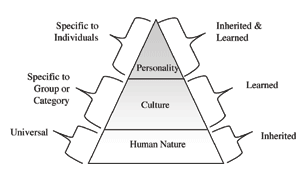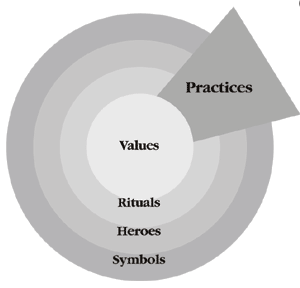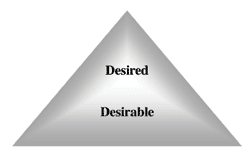
In order to visualize the place of pragmatics in the teaching of language and culture one must start by defining and locating culture. To do this it is helpful to refer to the pioneering work by Geert Hofstede who looked at the way local culture was expressed in corporate culture (in this case IBM worldwide). Hofstede (1991) differentiates between culture in the narrow sense of education, art, or literature, and culture as viewed in social or cultural anthropology. In the latter, broader view, culture is seen as patterns of thinking, feeling and acting. He visualized the position of culture in the following diagram (Figure 1):

In Hofstede's conceptualization, culture straddles the gap between the universal commonalities among all humans and the specific idiosyncrasies that individual people display in their personalities. Hofstede also used an onion diagram to illustrate his view of culture as a many-layered concept. At the heart of everything he places Values. Values are defined as broad tendencies to prefer certain states to others among dichotomies such as ugly-beautiful, dirty-clean, unnatural-natural, abnormal-normal, paradoxical-logical, irrational-rational, etc. The next layer out is labeled Rituals, which stand for collective activities such as greeting, paying respect, social/religious ceremonies, etc. Beyond Rituals is the layer labeled Heroes, which refers to persons alive or dead, real or imaginary who possess characteristics prized in the culture. According to Hofstede, the cultural purpose of heroes is to provide models for behavior. The final and outermost layer is labeled Symbols. It is in this layer that Hofstede places words (language), gestures, pictures, objects, clothing, hairstyles or other superficial (in his estimation) expressions of culture. Cutting through all of these layers he introduces the notion of Practice--the means by which a culture coherently and cohesively inculcates its values at each level of expression (see Figure 2).

The word practice comes from the same roots as the term used to describe the modern scholarly field of pragmatics. Praxis, found in Late Latin and in Greek, means "practice, action, doing," and comes from the stem of prassein "to do, to act" which is also the root of pragma (gen. pragmatos) "civil business, deed, act" which was used to describe customs, conventions, norms or traditions of behavior (Online Etymology Dictionary, 2003). In linguistics, pragmatics-as-use looks at ways people use language (and other signs, rituals or symbols) to accomplish communication goals. In addition, pragmatics-as-effects includes research into the effects on listeners as well as the effects on those who learn and use a particular language and the cultural views embedded in it. Researchers into pragmatics begin by making observations of language in use and then look for patterns, rituals and connections that lead to understanding of the values that underlie them. The basic unit of analysis is usually an utterance or speech act. Pragmatists start with what can be directly observed and try to build up their understanding of how patterns in these observations offer insight into the underlying values. To summarize, culture is learned human behavior specific to a group in which values are shared and expressed through various practices. These practices depend very heavily (although not exclusively) on language. A central problem to the study of pragmatics (and culture) is the distinction between what is desirable and what is desired. Desirable refers to how people think that the world ought to be. In this case the norm of behavior is absolute--right/wrong, agree/disagree. On the other hand, desired is what people want for themselves. In this case the norm is statistical--based on actual behavior. The gap between desirable and desired behavior is parallel to some extent with the competence and performance distinction in that the performance of language users (even native speakers) does not exactly match their competence. What we know (our knowledge) and what we do (our behavior or performance) is not always the same.
Similarly, what we know to be appropriate (desirable) to say and what we actually say can vary by situation and person. This variance that does not match the expectations of appropriateness and therefore is technically wrong is common among native speakers. If native speakers so easily get it wrong, imagine the pitfalls that await the language learner. The inclusion of a pragmatics component in language learning raises the awareness of these situations and provides the means and vocabulary to explain the whys and wherefores of appropriate use in an actual context. It also encourages the learner to look for a possible parallel situation to his or her own language and cultural context. If a parallel does exist the learner can note where, how and how much they overlap. If the learner finds no obvious parallel in his or her own language, the pragmatic awareness-raising task has offered some models of appropriate use in a context and opportunities for practice. Focusing on a cultural behavior that can be directly observed, then examining the specifics of the context and providing opportunities for interactive use, can accomplish all of this. So, where do desirable and desired fit on Hofstede's triangle (see Figure 3)? Clearly, individual personality types and traits will influence behavior. The influence of personality (in combination with context and other situational factors) may explain variance from what is generally agreed to be culturally desirable. Pragmatics-as-use research strives to clarify which of the observed (primarily linguistic) behaviors exemplify collective values and which of the observed behaviors are individual expressions. Pragmatics-as-effect research examines the changes and adaptations that people make as they develop language from childhood to maturity as well as those which learners make as they use a new language. The direct benefit to language learners of both types of research is reliable information about language use in defined contexts and the effects of such use.

Why not just study culture? It has often been said, "Who understands the language understands the world." This has often been interpreted as meaning "you cannot really translate anything fully correctly unless you really understand life completely and the world completely." However, I think that this interpretation is only partly correct and misses an important point. Note that it does not say, "Who understands the world understands the language." Such a statement is clearly nonsense. It is quite clear that understanding a language is a key to unlocking the fuller understanding of a world (or a culture). To conceptualize about culture without providing learners with opportunities for meaningful interaction using the target language will facilitate inter- and cross-cultural learning in only limited ways because it is all one-way information. You cannot really get information across just by showing pictures or telling about something. You can only really get knowledge across if you have a strong interaction between people, and for that you need language. We better serve our students by incorporating pragmatic awareness-raising and problem solving into tasks that require interaction in the target language.
Note: A shorter version of this article first appeared in Pragmatic Matters 3 (1), [serial 7], Fall 2001.
Hofstede, G. (1991). Cultures and organizations: Software of the mind. London: McGraw Hill.
Online Etymology Dictionary. (2003). Accessed January 21, 2003. Retrieved from www.geocities.com/etymonline/.